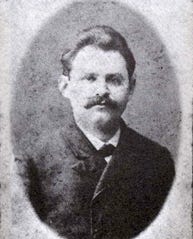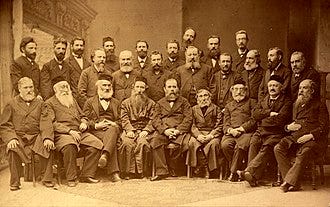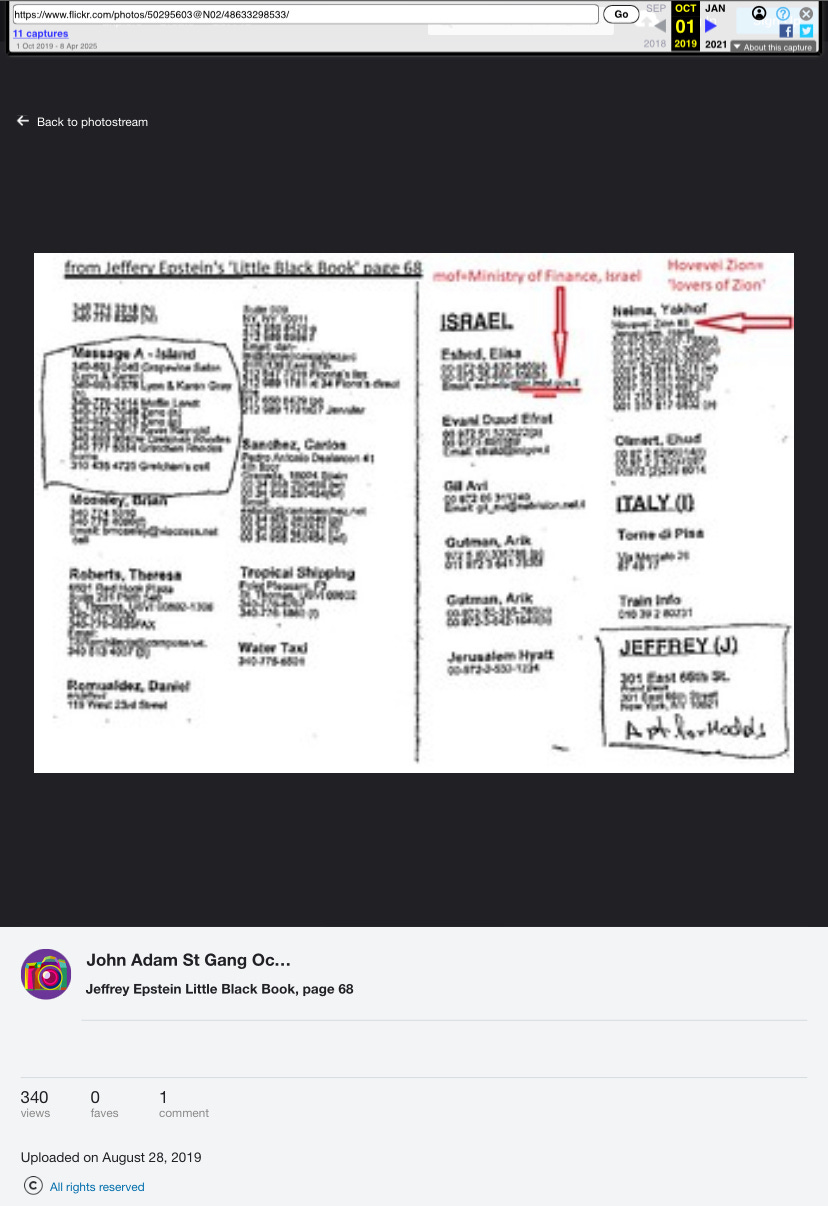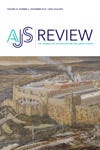Lovers of Zion - Zionism and Technocracy: The Engineering of Jewish Settlement in Palestine, 1870-1918
“Hovevei Zion, the name attached to an informal network of Jewish nationalist societies that sprang up in the wake of the 1881 pogroms and which was officially constituted in 1884”
Epstein is linked to Zionism, on account of his having contact details of Yakof Neima, Hovevei Zion (Lover of Zion) https://www.flickr.com/photos/50295603@N02/48633298533/
What’s love got to do with it? The emotional language of early Zionism
Pages 25-52 | Published online: 05 Apr 2020
This article looks to European Jewry between the mid-nineteenth and early twentieth centuries to illuminate the role of love in a modern nationalist movement. In the third quarter of the nineteenth century, the political activist Moses Hess (1812–1875) and the historian Heinrich Graetz (1817–1891) professed a sentimental love of Jews and of the land of Israel. In the 1880s, the hovevei tsion (Lovers of Zion) movement produced poetry in which attachment to Zion and the Jewish people was more romantic than sentimental, oscillating between a passive, mournful yearning for the land and an active, muscular striving to rebuild it. With the advent of Herzlian political Zionism, the Zionist labor movement, and the Zionist-Palestinian conflict, the more dynamic variety of romanticism became dominant, and it assumed more explicitly erotic and militant dimensions than had previously been the case. Older forms of sentimental love did not disappear, however. Until the end of his life, the Zionist leader Nahum Sokolow (1859–1936) remained convinced that sentimental love was Zionism’s overarching organizing principle.
https://www.tandfonline.com/doi/full/10.1080/13531042.2020.1736803
Lovers of Zion
The Lovers of Zion, also Hovevei Zion (Hebrew: חובבי ציון) or Hibbat Zion (Hebrew: חיבת ציון, lit. 'Love of Zion'), were a variety of proto-Zionist organizations founded in 1881 in response to the anti-Jewish pogroms in the Russian Empire and were officially constituted as a group at a conference led by Leon Pinsker in 1884.[1][2]
The organizations are now considered the forerunners and foundation-builders of modern Zionism. Many of the first groups were established in Eastern European countries in the early 1880s with the aim to promote Jewish immigration to Palestine, and advance Jewish settlement there, particularly agricultural. Most of them stayed away from politics.
History of the Jews and Judaism in the Land of Israel



19th century Palestine was inhabited by Muslims, Armenians, Christians, and Jews.[3] As early as 1840 Moses Montefiore advocated for the Jews in the Ottoman Empire, which controlled the areas of Palestine, meeting with British consul Henry John Temple, 3rd Viscount Palmerston to get Muhammad Ali of Egypt and Abdülmecid I, sultan of the Ottoman Empire to protect Palestinian Jewsfrom conflicts with the Ottomans.[4]
In 1850, according to the Ottoman census provincial yearbook, Palestine had 63,659 recorded households. Roughly 85% were Muslim, 11% were Christian and 4% Jewish. The Jewish population was recorded at about 14,730, and increased to 24,000 by 1882.[5]
In 1854, Judah Touro bequeathed money to fund Jewish residential settlement in Palestine. Moses Montefiore was appointed executor of his will. He used the funds for various projects, including building the first Jewish residential settlement and almshouse outside of the old walled city of Jerusalem in 1860, which is known today as Mishkenot Sha'ananim. Laurence Oliphant failed in a like attempt to bring to Palestine the Jewish proletariat of Poland, Lithuania, Romania, and the Turkish Empire (1879 and 1882).
In the Russian Empire, waves of pogroms of 1881–1884 (some allegedly state-sponsored), as well as the antisemitic May Laws of 1882 introduced by Tsar Alexander III of Russia, deeply affected Jewish communities. More than 2 million Jews fled Russia between 1880 and 1920. The vast majority of them emigrated to the United States, but some decided to form an aliyah to Ottoman-ruled Palestine.
In 1882, a group of ten Lovers of Zion enthusiasts from Kharkiv, headed by Zalman David Levontin and including noted philanthropists Isaac Leib Goldberg and Reuven Yudalevich, founded Rishon LeZion, the first Zionist settlement founded in the New Yishuv.[6] This was done despite obstacles posed by the Turkish government, which hindered the purchase of land.[7] Later, Bilu pioneers strengthened the settlement and enlarged it. For many years, textbooks gave Bilu the credit for the establishment of Rishon LeZion, but in the last decades—after a campaign by the veterans of Rishon and their descendants—'Lovers of Zion were given the credit as the founders of the city.
The Hovevei Zion tract Aruchas bas-ami was authored by Isaac Rülf in 1883,[8] and in 1884, 34 delegates met in Kattowitz, Germany (today Katowice, Poland). Rabbi Samuel Mohilever was elected the president and Leon Pinsker the chairman of the organization they named Hovevei Zion. Pinsker was aided by Shaul Pinchas Rabbinowicz.[9] The group tried to secure financial help from Baron Edmond James de Rothschild and other philanthropists to aid Jewish settlements in Palestine and to organize educational courses. In June 1887, another conference was held in Druskininkai.[10]
The Warsaw chapter was founded by L. L. Zamenhof, who was working on the first grammar textbook of Yiddish ever written, published under the pseudonym "Dr. X" only in 1909, in Lebn un visnshaft, in the article "Vegn a yidisher gramatik un reform in der yidisher shprakh".
To attain legal recognition by the authorities, the Russian branch of Hovevei Zion had to meet a demand to be registered as a charity. Early in 1890, its establishment was approved by the Imperial Russian government as "The Society for the Support of Jewish Farmers and Artisans in Syria and Eretz Israel," which came to be known as the Odessa Committee. It was dedicated to the practical aspects of establishing agricultural settlements, and its projects in 1890–1891 included help in the founding of Rehovot and Hadera and rehabilitation of Mishmar HaYarden.
One of the major donors was the famous tea merchant Kalonimus Wolf Wissotzky, who founded the largest tea company in Russia, Wissotzky Tea. Wissotzky financed agricultural colonies in Palestine and visited the country in 1884–1885. He later published a book about his visit.[11]
In 1897, before the First Zionist Congress, the Odessa Committee counted over 4,000 members. Once the Congress established the Zionist Organization, most of the Hovevei Zion societies joined.
Penslar, Derek Jonathan (1991). Zionism and Technocracy: The Engineering of Jewish Settlement in Palestine, 1870-1918. Indiana University Press. pp. 20–. ISBN 0-253-34290-2.
The Beginnings of Ḥibbat Ẓion: A Different Perspective
Yossi Goldstein
AJS Review
Vol. 40, No. 1 (APRIL 2016), pp. 33-55 (23 pages)
Published By: University of Pennsylvania Press
https://www.jstor.org/stable/26375036
https://www.jstor.org/stable/26375036?read-now=1
Lovers of Zion: A History of Christian Zionism :: By Thomas Ice
Published on: August 10, 2015 by RR2 Category:General Articles, Thomas Ice
In the last couple of years the secular community and some in the religious community have awakened to the reality that much of the American Evangelical community is very supportive of the modern state of Israel. And what is their reaction? They do not like it one bit! This support for Israel is perceived as an ever increasing danger with the possibility that Christian Zionism could bring about World War III.
Genesis 12:3 records God’ s promise to bless those who bless Abraham and his descendants (i.e., Israel). The Abrahamic covenant is confirmed to Abraham, Isaac, Jacob, and their descendants. It is repeated to them at least a minimum of twenty times in Genesis (12:1- 3, 7- 9; 13:14- 18; 15:1- 18; 17:1- 27; 22:15- 19; 26:2- 6, 24- 25; 27:28- 29, 38- 40; 28:1- 4, 10- 22; 31:3, 11- 13; 32:22- 32; 35:9- 15; 48:3- 4, 10- 20; 49:1- 28; 50:23- 25). Although the Abrahamic Covenant contains multiple features, it always includes the land promises to Israel. One of the most important questions that must be addressed is: Does this promise still stand or has it been changed? If these biblical promises are to be taken literally and still apply to Israel, and not the Church, it should not surprise anyone that such a view leads to Christian Zionism. Zionism is simply the belief that the Jewish people have been given the land of Israel by covenant promise from God and still have a current right to occupy that land. Christian Zionists are Christians who agree with this belief.
Read the long story https://www.raptureready.com/2015/08/10/lovers-of-zion-a-history-of-christian-zionism-by-thomas-ice/






